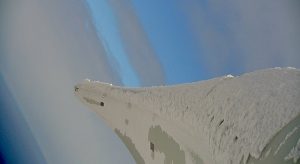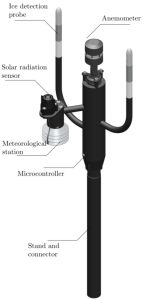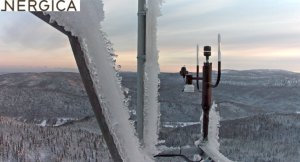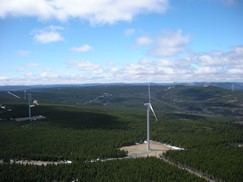Headquartered in Quebec City, Icetek is a developer of technological solutions for wind farms operating in cold-climate environments. Its products are designed for wind farm operators who have to deal with production losses due to icing. Indeed, icing affects the aerodynamic performance of a wind turbine’s blades and will therefore have a negative impact on electricity generation. Considering that the winter months are the windiest periods of the year, and that cold air is denser than warm air, icing can cause annual production losses of up to 25% for a wind farm.

Headquartered in Quebec City, Icetek is a developer of technological solutions for wind farms operating in cold-climate environments. Its products are designed for wind farm operators who have to deal with production losses due to icing. Indeed, icing affects the aerodynamic performance of a wind turbine’s blades and will therefore have a negative impact on electricity generation. Considering that the winter months are the windiest periods of the year, and that cold air is denser than warm air, icing can cause annual production losses of up to 25% for a wind farm.
Icetek has its origins in a 2012 research project carried out by a PhD student at Université Laval. Future Icetek co-founder André Bégin-Drolet was working on a wind sensor capable of detecting traces of icing. From this project was born the idea to develop an ice detection system for wind farms.
Icetek is therefore a spin-off of Université Laval that was founded four years ago (2020). With six full-time and three part-time employees, the company is currently commercializing its ice detection system named IC-1.
Already present in eastern Canada and eastern United States, the rapidly growing company is looking to expand into new markets, notably western Canada, the rest of the US and later Europe.
IC-1: Ice Condition Monitoring System
 In a word, the IC-1 ice condition monitoring system is a sensor that detects the conditions that lead to icing. In reality, it is not merely a detector but rather a comprehensive meteorological station that measures wind speed and direction, temperature, air pressure, relative humidity and solar irradiance. The meteorological station is also equipped with two patented probes that use a technology unique to Icetek.
In a word, the IC-1 ice condition monitoring system is a sensor that detects the conditions that lead to icing. In reality, it is not merely a detector but rather a comprehensive meteorological station that measures wind speed and direction, temperature, air pressure, relative humidity and solar irradiance. The meteorological station is also equipped with two patented probes that use a technology unique to Icetek.
What makes the detection system unique is that the probes can measure liquid water content (LWC). When combined with other meteorological data, LWC measurements can be used to identify the conditions that lead to icing, the start and end times of the episode, as well as the intensity of the icing event. Liquid water content is defined as the mass of liquid water contained in a cubic metre of air. It is used to categorize the ice (glaze, rime, wet snow).
Thanks to IC-1, it is possible to predict how ice will accumulate on the surrounding structures and at what rate. It is also possible to identify the type of ice and measure its thickness on the surface of the structure. The detection signal can then be integrated into the turbine’s control system or de-icing system in order to significantly reduce the impact of icing on wind power production.
Unique feature of the technology

Nowadays, most ice sensors measure either the presence or the accumulation of ice. IC-1 detects not only ice accretion, but also the underlying cause: in the case of freezing rain, the detection system will detect the rain and not only the ice that adheres to the surface.
Determining the parameters that lead to icing allows for more timely detection than what other sensors on the market can offer, which may be appealing to wind farm operators who wish to activate their de-icing systems before ice accretion actually begins. In other words, the sensor indicates the presence of conditions conducive to icing before the latter begins to negatively affect the turbine’s power production, which allows for a more proactive approach.
Lastly, as mentioned above, the detection system developed by Icetek measures liquid water content (LWC). This detection method, which has been patented by Icetek, can be used to characterize the type of ice detected (rime, wet snow, glaze, etc.). This detection system is one of the few models on the market that is capable of achieving this result.
Application of the technology
Some of Icetek’s customers use the detection system to switch on the de-icing systems of their turbine(s) as soon as the monitoring system detects the earliest phases of an icing event. This results in lower production losses for wind turbines during an icing event.
Other customers use the ice detection solution even if their turbines are not equipped with any de-icing systems. The rationale here is to perform a preventive shut-down of the turbine(s), which reduces ice accretion and allows for a quicker restart once weather conditions become more favourable again. Because the sensor also identifies when icing conditions have ended, it can also be used to re-start the turbine.
The Icetek-developed solution is also intended for customers operating wind turbines close to population centres or in areas frequented by the public. Should an icing event occur, the detection system will stop the wind turbine(s) before there is any significant ice accretion and, in doing so, protect the public by preventing ice shed from the blades.
Projects in which the technology has been used

The first major project in which the IC-1 sensor was deployed was the Caribou Wind Park near Bathurst, New Brunswick, where half of all wind turbines were fitted with the detection system. The project has helped improve the detection system significantly by switching from a cup anemometer to an ultrasonic anemometer and grouping the different sensors into an integrated system.
Since the start of the Caribou Wind Park project, IC-1 has been installed at more than 25 other wind farms and the detection system can now be used to control the machines. As an integral part of the system, it can be used to shut down the turbine or activate its de-icing system at the appropriate time.
Cold-climate wind turbines operate in harsh conditions, including wide temperature swings throughout the year, electrical disturbances, ice shed and vibrations. Technology development projects have helped rethink the ice detection system and adapt it to the requirements of this environment.
Further evolution of the project
Icetek has developed a software solution called IceBrain that is designed to use data collected from IC-1 to optimize production strategies.
Efforts are also being made to facilitate data collection by an IC-1 fixed to a tower; in this case, the sensor does not move whenever the wind changes direction, unlike a nacelle-mounted instrument. The next step will be to test the product on met towers in collaboration with Nergica. One aspect in which there is room for improvement is the product’s heating system: the detection system can consume up to 300 W, which is negligible for a wind turbine, but not for a met mast.
In the future, IC-1 will be used at wind farms operating in cold climates not only in North America but also in Europe, where there is a high demand for wind power. More importantly, Icetek is in discussions with turbine manufacturers in order to fit their turbines with this detection system when they are first erected. In this regard, Icetek aims to install its systems in collaboration with major turbine manufacturers in Fall 2024 and Summer 2025 in an effort to demonstrate the performance of its technologies compared to other existing sensors.
